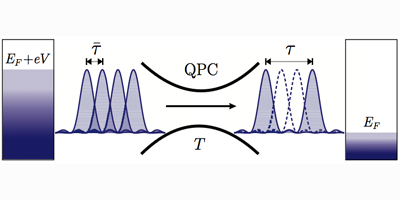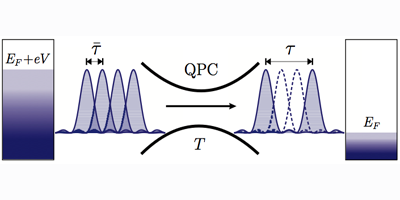Electrons Arrive By and By
Current fluctuations contain a wealth of information about electron transport in mesoscopic conductors. The waiting time distribution—the distribution of time between arrivals of charge carriers at a particular point—provides a complementary perspective. This quantity has been analyzed thus far mostly for classical systems or bosonic quantum systems. Waiting time distributions are particularly useful in the study of physics on short timescales, but a full quantum theory to permit the study of mesoscopic fermionic systems has been lacking.
Now, Mathias Albert and colleagues from the University of Geneva, Switzerland, have published a study in Physical Review Letters in which they develop such a quantum theory. Albert et al. illustrate their approach by using the example of a quantum point contact, which is a narrow constriction between two wide conducting regions, characterized by a controllable transmission probability. For a fully open contact, the electrons, although not evenly spaced due to their wave nature, have an average waiting time of . As the contact is pinched off, the transmission probability approaches zero, and the electrons start arriving at uncorrelated intervals, similar to the statistics for radioactive decay. The analysis of waiting time distributions in fermionic systems has important consequences for our understanding of mesoscopic transport. – Sarma Kancharla





